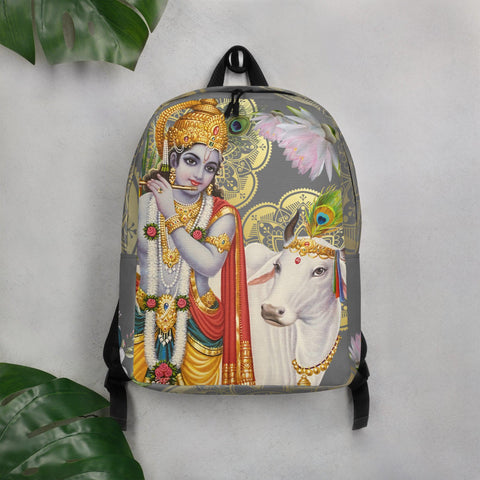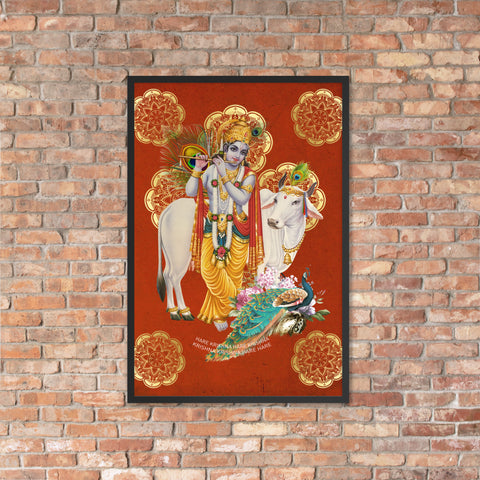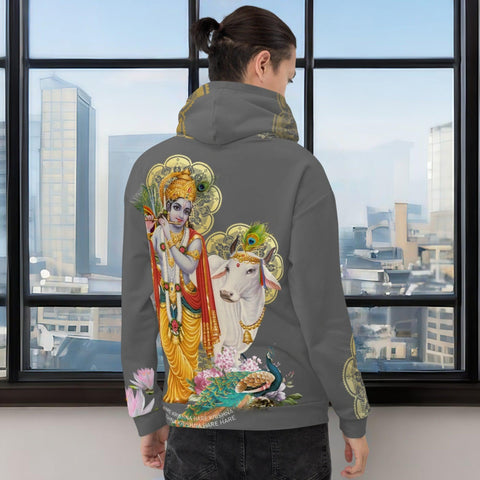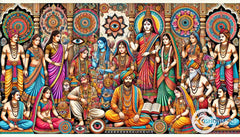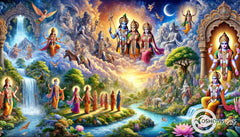Krishna: The Life, Teachings, and Legends of a Divine Being
Posted by Massimiliano Geraci

Many people find themselves yearning for deeper spiritual meaning and connection in their lives, looking to ancient wisdom for guidance. The stories and teachings of Krishna offer a rich tapestry of lessons that resonate across cultures and centuries.
A central figure in Hinduism, Lord Krishna represents love, duty, morality, and divine play.
Krishna is known not just for his battlefield discourse in the Bhagavad Gita but also for his mischievous childhood deeds and profound philosophies that continue to inspire millions around the globe.
This blog will explore the life, legends, and enduring relevance of God Krishna to provide insights into how his teachings can be applied today. Discover Krishna’s influence on spirituality, culture, and personal growth.
Continue reading to awaken your heart to divine love.
Who is Krishna?
Krishna stands as a central figure in Hindu dharma, revered not just as a hindu deity but also as a symbol of devotion and divine love. Born in Mathura around 3228 BCE, his life's narratives are richly detailed in texts like the Bhagavata Purana and Mahabharata.
Krishna is worshipped across various cultures in India, embodying the complex philosophies of Vaishnavism and bhakti movement which emphasize loving engagement with the divine.
Whenever dharma declines and the purpose of life is forgotten, I manifest myself on earth. - Bhagavad Gita
As an avatar of Vishnu, one among the Trimurti responsible for preserving creation, Krishna's incarnations serve to restore cosmic order. His teachings to Arjuna on the battlefield of Kurukshetra, immortalized within the Bhagavad Gita, offer profound insights into duty (dharma), righteousness, and detachment.
These lessons continue to guide millions towards spiritual awakening and moral clarity. Through his playful yet meaningful interactions with devotees like Radha and actions that underscored his godliness—like lifting Govardhana Hill or vanquishing demons—Krishna became emblematic of divinity enmeshed in human experiences.
Understanding Krishna's Life and Birth
Krishna's life begins in an atmosphere of peril and divine intervention, marking his birth as a momentous event in Hindu scripture. Born to Devaki and Vasudeva in the dark cells of Kamsa's prison, his early life was underscored by miracles and the fulfillment of ancient prophecies.
Legend tells us that at the time of his birth, chains fell and doors unlocked magically, allowing Vasudeva to carry Krishna across the Yamuna River to safety. This act not only saved Krishna from King Kamsa, who feared a prophecy that predicted his death at the hands of Devaki's eighth son but also encapsulated Krishna’s destiny as a divine being destined to shape the course of history.
Raised by Nanda and Yashodha among cowherds in Vrindavan, Krishna exhibited divine powers from a tender age. His childhood is rich with tales of him performing miracles, such as defeating demons sent by Kamsa or lifting Govardhan Hill to protect his village from devastating rains.
These legends are not just stories; they serve as foundational narratives within Gaudiya Vaishnavism and other sects venerating Krishna’s incarnations. Beyond mere mythology, these accounts symbolize Krishna’s role as protector and guide for humanity – themes central to understanding Hindu philosophy surrounding divinity and moral guidance conveyed through epic poetry like Bhagavat Purana.

Krishna as an Incarnation of Vishnu
Moving from the story of Krishna's miraculous birth and early years, we step into a profound aspect of his divine saga: his role as an incarnation of Vishnu. Described in the Puranas, Krishna embodies Vishnu's eighth avatar, brought forth to bring dharma (righteousness) back to Earth during times of distress and turmoil.
This belief is central to the religious texts and underscores Krishna's significance within Hinduism.
In this revered narrative, Vishnu took form on Earth as Krishna in the ancient city of Mathura, born to Vasudeva and Devaki amidst tyrannical forces threatening Dharma. As an avatar, he demonstrated godly virtues through acts ranging from playful mischief with gopis and lifting Govardhan Hill for protecting villagers, to imparting timeless wisdom in the Bhagavad Gita.
Notably, his teachings offered during the Kurukshetra war serve as a spiritual compass for millions even today. His life events are celebrated widely across India through festivals such as Krishna Janmashtami, marking his birth’s divine intervention by Vishnu to re-establish righteousness on Earth.
The Legends Surrounding Krishna’s Childhood
Krishna's childhood brims with tales that intertwine the divine with the playful, capturing hearts across generations. Born at a time of turmoil to Vasudeva and Devaki in the dungeons of Kamsa, king of Mathura, his early years were marked by miraculous events.
Krishna's father smuggled him out to safety under a stormy night, leading him to Nanda and Yashoda in Gokul. This foster family raised Krishna away from his uncle's wrathful gaze.
Krishna exhibited extraordinary powers from a tender age, hinting at his divine origin as an avatar of Vishnu. He charmed the villagers with his flute playing and mischievous antics like stealing butter.
Yet it was not all play; young Krishna performed several miracles that saved his community from various perils. These include vanquishing demons sent by Kamsa to kill Krishna and lifting Govardhan Hill on just one finger to shelter his people from relentless rains.
Stories like these are not merely accounts of heroism but serve as lessons promoting faith over fear among followers—a testament echoed throughout Hindu teachings till today.

What is Krishna’s Role in Hindu Dharma?
Krishna plays a multifaceted role in Hindu Dharma, serving as both a divine guide and an exemplar of dharma itself. Through his teachings, particularly those found in the Bhagavad Gita, Krishna offers deep insights into the nature of duty, righteousness, and devotion.
He emphasizes the importance of performing one's duties according to their dharma without attachment to the outcomes. This principle guides followers to living a life of balance and moral integrity while maintaining a deep connection with the divine.
Whenever righteousness wanes and unrighteousness increases I send myself forth. - In this promise from the Bhagavad Gita, Krishna assures devotees of his recurrent presence in maintaining cosmic order.
He also profoundly impacts Hindu practices through rituals and festivals that celebrate aspects of his life—from his birth in Mathura to his playful childhood in Vrindavan—and teachings that continue to shape spiritual pursuits like meditation, devotion (bhakti), and the pursuit of higher consciousness.
As worshipped as Svayam Bhagavan within various traditions such as Krishnaism, he is revered for his divine play (lila) and for establishing dharma on earth through direct intervention and guidance.
The Teachings of Krishna in the Bhagavad Gita
In the battlefield of Kurukshetra, as chronicled in the epic Mahabharata, the teachings of Krishna to Arjuna form the crux of the Bhagavad Gita. Here, amidst a looming war that pits kin against kin, Krishna imparts profound spiritual wisdom and guidance.
Serving as Arjuna's charioteer, he reveals insights on dharma (duty/righteousness), karma (action), bhakti (devotion), and moksha (liberation). These conversations underscore an essential blueprint for dealing with life's moral dilemmas and emphasize performing one's duty without attachment to personal gain.
The Bhagavad Gita presents Krishna not just as a historical figure but also as an incarnation of Vishnu, embodying divine wisdom. Through allegories and direct discourse, he counsels Arjuna on overcoming despair and doubts before combat.
This narrative is pivotal in Hindu dharma for its exploration of how to live virtuously, balance material responsibilities with spiritual goals, and attain ultimate realization or closeness with hindu Gods.
Shifting focus from these timeless teachings lays a foundation for understanding Krishna’s broader influence on cultural practices across India.

The Concept of Dharma Through Krishna's Lens
Krishna elucidates the concept of dharma in a profound way, highlighting its essence as the moral and righteous path. Through his teachings in the Bhagavad Gita, particularly to Arjuna on the battlefield of Kurukshetra, Krishna redefines dharma and emphasizes its significance in achieving both personal fulfillment and societal harmony.
He advises warriors like Arjuna, guiding them through moral dilemmas by advocating for action rooted in duty rather than personal gain or loss. This discourse between Krishna and Arjuna encapsulates a central theme of Hindu philosophy - that one's actions should align with their divine purpose or svadharma.
Krishna's perspective transforms understanding of dharma from mere adherence to rituals or societal norms to an alignment of human being with cosmic order and individual duty. His life itself serves as a testament to this broader interpretation of dharma, demonstrating how adherence to one's true nature can foster spiritual growth and social welfare.
By living out his roles as a shepherd, warrior, advisor, and friend with unwavering commitment to righteousness, Krishna exemplifies how diverse responsibilities can coexist within one’s life when guided by dharma.
Such teachings have significantly influenced Hindu practices across generations, making Krishna's insights into dharma pivotal for followers seeking guidance on fulfilling their roles within society while pursuing spiritual elevation.
Krishna’s Influence on Hindu Practices
Krishna's teachings and stories have deeply shaped Hindu practices, embedding themselves into the spiritual fabric of India. His life narratives, articulated through texts like the Bhagavad Gita, serve as foundational guides for living a righteous path (Dharma) in Hinduism.
Devotees find guidance in his words on karma (action), bhakti (devotion), and jnana (knowledge), principles that underpin many Hindu rituals and philosophies today.
Across India, from Uttar Pradesh where Mathura vibrates with tales of his birth, to Gujarat where Dwarka stands as a testament to his later years, worship of Krishna manifests in diverse and rich traditions.
Festivals like Krishna Janmashtami celebrate his divine descent into this world, drawing millions into liturgical performances, devotional singing, and communal worship. This devotion also thrives globally through movements like the International Society for Krishna Consciousness (ISKCON), popularizing the Hare Krishnas mantra beyond Indian borders.
Through these expressions of faith and practice, Krishna continues to inspire moral values and devotional fervor among Hindus worldwide.
How is Krishna Worshipped?
Devotees honor Krishna in diverse ways across India, reflecting his multifaceted nature. In temples and homes, worship involves rituals like singing the Hare Krishna mantra, a practice that gained global attention through the efforts of A.
C. Bhaktivedanta Swami Prabhupada, founder of the Hare Krishna movement. Offerings of food, flowers, and incense are made to idols representing Krishna's various forms—from baby Krishna crawling on hands and knees to his role as a supreme god alongside goddess Lakshmi.
Festivals such as Krishna Janmashtami celebrate his birth with great enthusiasm in cities like Mathura—his birthplace—and Vrindavan where he spent his early years. Devotees fast until midnight—the believed hour of his birth—followed by feasting and dramatic recreations of episodes from his life.
Special prayers are offered at significant times of day to honor stories like those involving Balarama or battles fought for dharma’s sake against adversaries such as Kauravas.
"The flute-playing god is worshipped not just in grand temples but also in the humble abodes of millions who seek solace in his teachings."
Different Forms of Worship in India
Krishna's worship in India showcases a splendid tapestry of rituals and practices deeply rooted in the country's culture. These sacred ceremonies embody the essence of devotion, threading through the fabric of Indian spirituality with vibrancy and diversity. Here are different forms of worship that highlight the multifaceted nature of Krishna devotion across India:
1. Temple Worship: Followers flock to temples dedicated to Krishna, such as those in Mathura and Vrindavan, engaging in darshan where they gaze upon the deity's image with reverence. These temples often house ancient idols, like those inscribed with mentions from historical texts like the Brahmi script or linked to legends of the Yadava clan.
2. Festivals: Major festivals like Krishna Janmashtami celebrate Krishna's birth with unfettered joy and communal participation. Devotees partake in singing hymns, dancing, and enacting plays that narrate segments of Krishna’s life, from his miraculous birth to his playful childhood acts.
3. Chanting Hare Krishna Mantra: The global Hare Krishna movement has popularized the chanting of this mantra as a form of meditation and spiritual connection, echoing teachings from ancient Vedas and promoting a sense of unity among practitioners worldwide.
4. Bhagavad Gita Study: Krishna imparted the sacred teachings found in the Bhagavad Gita to Arjuna on the battlefield of Kurukshetra, offering profound insights into duty (dharma) and righteousness. Study groups and discussions focused on these teachings offer devotees a deeper understanding of their faith.
5. Ritualistic Offerings: Devotees present offerings such as flowers, food (prasad), incense, and lamp-lighting (aarti) to idols or images of Krishna in both temple settings and homes, symbolizing surrender and devotion to God.
6. Pilgrimages: Sacred journeys to places associated with Krishna’s life—Mathura, Vrindavan, Dwarka—provide believers a tangible connection to their deity through immersion in sites where significant events occurred according to legends.
7. Artistic Expressions: Depictions of cowherd Krishna playing the flute or surrounded by gopis (cowherd girls), crafted through various art forms like painting or sculpture, serve not only as objects of veneration but also as means for devotees to visually engage with divine narratives.
8. Prayer Circles (Satsang): Gatherings for collective prayer encourage spiritual discourse among community members, reinforcing social bonds within clusters of Krishna worshippers while fostering an environment for shared religious experience on all levels.
Each form encapsulates unique aspects specifically for connecting hearts mindfully with divine energies inherent within Hinduism’s rich tradition embracing adoration Krishna brings millions closer spiritual enlightenment daily life practices continue evolve maintain relevance amid rapidly changing contemporary society transitions next discussion importance rituals festivals celebrating Krishna’s legacy throughout history modern times alike advances meaningful exploration into profound impacts these cultural expressions have shaping personal communal identities amidst broader context human endeavor strive understanding divinity world around us.
Rituals and Festivals Celebrating Krishna
Moving from the diverse forms of Krishna worship across India, we transition into the core of devotion - the rituals and festivals dedicated to celebrating this divine being. These events honor Krishna's life and teachings and serve as a bridge connecting devotees globally through shared rituals and joyous celebrations.
1. Krishna Janmashtami: This is the most significant festival dedicated to Lord Krishna, marking his birth. Celebrated with great fervor across India, especially in places like Mathura and Vrindavan, devotees observe fasts, participate in devotional singing, and enact the life events of Krishna at midnight, symbolizing his moment of birth.
2. Radha Ashtami: Commemorating the birth of Radha, Krishna's consort, this day witnesses elaborate ceremonies in temples across Vrindavan. Devotees offer prayers to both Radha and Krishna, highlighting their eternal love story which is central to Hindu mythology.
3. Govardhan Puja: Stemming from the legend where child Krishna lifted Govardhan Hill to protect the villagers of Vrindavan from Indra's wrath, devotees on this day prepare a large variety of vegetarian food offerings in a ceremony known as Annakut.
4. Rath Yatra: While primarily associated with Lord Jagannath (a form of Vishnu/Krishna), Rath Yatra festivals have become synonymous with Krishna worship too. In these grand processions, idols of Krishna are placed on chariots and pulled by devotees through streets, symbolizing Krishna's journey from Gokul to Mathura.
5. Holi: The festival of colors is deeply connected with Krishna's playful antics in Vrindavan where he applied colors on Radha and other gopis. Holi celebrations in regions associated with Krishna’s life such as Mathura-Vrindavan feature vibrant play with colors and devotional music sessions (kirtans).
6. Gita Jayanti: Marking the day when Lord Krishna imparted the Bhagavad Gita's teachings to Arjuna on the battlefield of Kurukshetra; it involves reading verses from the Gita among communities and discussions on its relevance today.
7. Kayadhu Lagna Poojan: Tying closely with astrology beliefs prevalent during ancient times around Abhira people who revered stars alignment at times deemed sacred for their gods; Kayadhu Lagna Puja specifically venerates the exact astrological moment believed to be when Lord Vishnu incarnated as Lord Hari (Krishna). Devotees engage in special prayers during this exact moment annually.
8. Nandotsav: Celebrated the day after Janmashtami, Nandotsav rejoices Nanda Maharaj (Krishna’s foster father) distributing gifts among citizens for being blessed with Lord Hari (Krishna) as his son - commemorating a father’s happiness upon his child’s arrival.
9. Gopa Ashtami: This festival respects those precise moments wherein baby Hari ventured into tending calves transitioning into cow herding phase; reminding followers about embracing responsibilities while upholding Dharma like Prince Rama did among Pandavas despite adversities faced throughout history till battlelines were drawn at Kurukshetra showcasing ultimate righteousness triumphing over misdeeds.
Through these rituals and festivals, devotees relive legendary tales illustrating moral virtues while fostering communal unity under spiritual ambiances created through
The Significance of Krishna Janmashtami
Krishna Janmashtami celebrates the birth of Krishna, worshipped as the eighth incarnation of Vishnu and also revered as a supreme god in his own right. This festival marks an important day across India and in many parts of the world where Hinduism is practiced.
Devotees fast, pray, sing hymns, and engage in rituals to honor this divine birth. Temples witness elaborate celebrations, with Mathura - Krishna's birthplace - transforming into a vibrant hub of devotion and festivity.
Janmashtami brings to life the enduring ethos of love, valor, and dharma that Lord Krishna represents.
In every corner where this festival is observed, stories from Krishna's life are recounted emphasizing his role as a harbinger of justice and righteousness. The breaking of the Dahi Handi reflects Krishna's playful nature and his inclination towards helping others even during his early years crawling on hands in Nanda's courtyards.
Every chant sung resonates with vibrancy, evoking spiritual awakening among followers who see this occasion not just as a remembrance but as an invitation to incorporate these virtues into their own lives.

Why is Krishna Important in Modern Times?
The influence of Krishna extends far beyond ancient scriptures, shaping modern spirituality and global cultural landscapes. The Hare Krishna mantra, a core practice of the Krishna Consciousness Movement founded by Chaitanya Mahaprabhu, has transcended Indian borders, becoming a universal chant for peace and spiritual renewal.
This movement illustrates how ancient wisdom adapts to contemporary needs, offering solutions to life's pressing challenges. It encourages individuals to live with purpose and compassion in a rapidly changing world.
Krishna’s teachings in the Bhagavad Gita remain relevant today as they address fundamental aspects of duty, morality, and the pursuit of happiness within society's intricacies. Leaders and thinkers across the globe draw upon this sacred text for guidance in governance, corporate ethics, and personal development.
In 2024 and beyond, these lessons continue to inspire discussions on dharma (righteous path) among scholars at prestigious institutions such as Harvard University where courses integrate timeless wisdom into modern contexts.
Through art forms like Kathakali from Kerala or classical music concerts featuring compositions about Krishna’s life by Vidisha-based performers; his stories foster a rich tapestry of cultural expression that resonates worldwide.
Krishna Consciousness Movement
The Krishna Consciousness Movement, also recognized globally through the Hare Krishna mantra, rejuvenates ancient Hindu practices by emphasizing devotion to Lord Krishna as the supreme deity.
Founded in 1966 by A.C. Bhaktivedanta Swami Prabhupada, this movement aims to spread the teachings of love and devotion found within Vedic scriptures like the Bhagavad Gita and Srimad Bhagavatam.
Prabhupada's journeys from India to New York marked a transformative epoch, introducing Western societies to bhakti yoga— a path leading directly to spiritual enlightenment and a personal relationship with Krishna.
Influencing millions worldwide, ISKCON (International Society for Krishna Consciousness) establishes temples, eco-villages, farm communities, and educational institutions promoting sustainable living in harmony with Vasudeva's lessons on unity and peace.
Members adopt lifestyle changes advocating vegetarianism, chanting the Hare Krishna mantra daily which is believed to connect one directly with divine consciousness. The celebration of festivals like Krishna Janmashtami brings together devotees from various backgrounds in communal joy over commemorating Sri’s birth and his vibrant life stories that continue guiding individuals toward moral clarity and self-awareness in today’s modern challenges.
Relevance of Krishna’s Teachings in 2024
Krishna's teachings, immortalized in texts like the Bhagavad Gita, resonate profoundly with contemporary issues faced by individuals across the globe. In 2024, the principles of Dharma (righteousness), Karma (action), and Bhakti (devotion) stand as guiding lights amidst a landscape often clouded by uncertainty and ethical dilemmas.
These timeless precepts encourage a holistic approach to living, advocating for actions rooted in morality rather than outcomes driven by selfish desires. As societies grapple with challenges ranging from environmental crises to disparities in wealth and access to resources, Krishna’s counsel offers a pathway toward harmony and sustainability.
Embracing Krishna's philosophies paves the way for unity, underscoring the interconnectedness of all life forms. His message promotes peace over conflict and love over hatred, principles particularly pertinent as humanity moves through technological advancements and strives for global solidarity.
For scholars of anthropology, spirituality enthusiasts, and art lovers alike, studying Krishna’s narrative provides an exploration into ancient Indian culture and insights applicable to fostering a just society in 2024.
Engaging with these teachings allows individuals to cultivate inner transformation which is crucial for addressing external challenges effectively.
Exploring how different cultures interpret Krisha's teachings reveals further layers of understanding that enrich our appreciation for diversity and shared human values.
Global Influence of Krishna’s Philosophy
Krishna's teachings in the Bhagavad Gita have spread far beyond India, touching lives around the globe and influencing various spiritual movements such as the Hare Krishna (mantra), which reverberates through streets from Bengal to Western cities.
This mantra serves not just as a religious chant but also as a medium connecting diverse cultures with the profound principles of love, devotion, and dharma that Krishna espoused. Followers find solace in these teachings, seeking guidance on how to navigate life's challenges while maintaining inner peace and fulfilling their duties.
The philosophy of Krishna has also left its mark on notable figures in both Eastern and Western spheres. For example, historical records like the Heliodorus pillar indicate early Greek engagement with Hindu deities including Vasudeva-Krishna dating back to 2nd century BCE, illustrating an ancient cross-cultural appreciation for his divine persona.
Present-day influencers such as Ram Dass and musicians like George Harrison have drawn inspiration from Krishna's wisdom, further spreading his message across cultural boundaries. These examples highlight how Krishna’s philosophical legacy transcends geographical limits, shaping spirituality across time and space without losing its essence or significance.
Where are Sacred Places Associated with Krishna?
Mathura, the birthplace of Krishna, stands as a pivotal landmark in the history of India and holds profound spiritual significance for devotees. Recognized not just for its historical eminence but also as a symbol of divine love and virtue, Mathura invites millions from around the globe to experience its sacred aura.
This city, where Krishna was born to Vasudeva and Devaki, amidst the chaos of Kamsa's tyranny, serves as a living testament to the endurance of dharma over adharma.
Vrindavan is another cherished site deeply embedded in Krishna's life narrative. It is here that Krishna spent his childhood years, engaging in playful mischief with Radha and performing miracles that are celebrated by followers even today.
The intricate lanes of Vrindavan echo with tales of young Krishna’s exploits —from dancing on the vicious serpent Kaliya to lifting Govardhan hill—imbuing visitors with a sense of wonderment and devotion.
The essence captured in art forms across generations speaks volumes about Vrindavan’s perpetual influence on spirituality and Indian culture.
The land echoes the footsteps of divinity where Lord Krishna walked.
Mathura: Birthplace of Krishna
Mathura holds a pivotal place in the vast tapestry of Hindu tradition, celebrated as the birthplace of Krishna. According to the Brahma Vaivarta Purana, this sacred city by the Yamuna River witnessed the divine arrival of Vishnu's incarnation into the world.
The Mora Well Inscription near Mathura further corroborates this spiritual heritage, shedding light on historical devotion to Lord Krishna in these ancient lands. As devotees and scholars explore its streets and temples, they find themselves walking through pages of religious texts that have shaped millennia.
The city thrives as a spiritual center and a beacon for anthropologists and lovers of Indic art. Here, stories from texts like Bhagavad Gita come alive among the architecture and artifacts that dot Mathura’s landscape.
Sites such as Krishna Janmabhoomi mark where Nanda and his wife Yashoda are said to have raised young Krishna, offering an intimate glimpse into past lives intertwined with divinity.
Every corner tells part of Vrishni heroes' tales, inviting visitors to explore deeper into understanding how Krishna established dharma amidst chaos, echoing his teachings across time.

Vrindavan: Land of Krishna’s Early Life
Leaving Mathura, the birthplace of Krishna, we journey into the sacred groves of Vrindavan, where tales of his early life unfold. This town holds a special place in Hindu theology as where Krishna spent his childhood and adolescence engaging in divine play.
Here, amidst the lush forests and along the banks of the Yamuna River, young Krishna's playful antics with his friends and tender moments with Radha blossomed into eternal stories of love and devotion.
Vrindavan remains a pivotal pilgrimage site where devotees from across the world converge to retrace Krishna’s footsteps. The town is dotted with ancient temples dedicated to him and his consort Radha; each shrine narrates a slice of their immortal romance or showcases one of Krishna's miraculous deeds.
Prominent among these are tales capturing scenes like little Krishna crawling on his hands or dancing atop Kaliya, a venomous serpent. Vrindavan’s spiritual ambiance is further heightened during festivals like Holi and Janmashtami when reenactments bring these legends to vibrant life against a backdrop ringing with chants praising Nanda's son’s name.
Through its tangible connection to divine playfulness (lila), Vrindavan continues to capture hearts as vividly today as it did millennia ago.
Other Important Temples and Holy Sites
Krishna's divine narrative weaves through the fabric of Hindu spirituality, marking sacred sites across the Indian subcontinent that draw millions of devotees and art lovers annually. These holy places transcend mere geographical locations, becoming epicenters of spiritual journeys and cultural heritage.
1. Dwarkadhish Temple in Gujarat stands as a monumental beacon of faith, where Krishna is believed to have established his kingdom. This majestic structure, with its elaborate craftsmanship, epitomizes architectural brilliance from as early as the 16th century.
2. Jagannath Temple in Puri, Odisha, famous for its annual Rath Yatra, venerates Krishna as Lord Jagannath. The temple's history stretches back to the 12th century and embodies an amalgamation of majestic sculptures that narrate Krishna's life.
3. Guruvayoor Temple in Kerala is renowned for its strict worship rituals dedicated to Krishna under the deity form of Guruvayoorappan. This temple's idol is said to be created by Vishwakarma, the divine architect, symbolizing a fulcrum of divine energy.
4. ISKCON Temples globally have redefined Krishna worship in the modern era, connecting diverse cultures through shared spirituality centered around love for Krishna. These temples serve not just as places of worship but also as cultural hubs promoting vegetarianism and non-violence.
5. Nathdwara Shrinathji Temple in Rajasthan pays homage to Krishna as Shrinathji. Established in the 17th century following a divine indication to relocate the deity from Vrindavan amidst Mughal persecution, this temple signifies resilience and eternal devotion.
6. Udupi Sri Krishna Matha in Karnataka is distinctive for its Kannada architecture and a unique statue of Krishna turned towards his devout follower Kanakadasa after he was discriminated against due to his lower caste status - showcasing Krishna's accessibility to all.
7. Radha Damodar Temple in Vrindavan holds historical significance with its connections to both Jiva Goswami and Sanatana Goswami who laid down significant theological works related to bhakti yoga here during the 16th century - making it a center for learning and devotion.
8. Govind Dev Ji Temple in Jaipur was built specifically by Sawai Pratap Singh II for the deity that appeared in Rupa Goswami’s dream; it reflects an intersection between personal devotion and royal patronage toward celebrating Krishna’s teachings on universal love and dharma.
Each site turns pages from history books alive with tales of miracles, devotion, artistic expression, and unparalleled faith; guiding humanity to spiritual enlightenment through diverse paths leading back to one divine source: Krishna.
How Does Krishna’s Story Influence Popular Culture?
Krishna's narratives have seamlessly woven into the fabric of popular culture, inspiring an array of artistic expressions from ancient paintings to contemporary cinema. Artists and musicians often draw upon his life stories, employing symbols like the Sudarshana Chakra or the flute to evoke deep spiritual meanings.
In literature, Krishna’s childhood antics and profound teachings in texts such as the Bhagavad Gita serve as a rich source for storytelling, providing moral lessons that resonate across ages.
The annual celebration of Krishna Janmashtami showcases his cultural significance, bringing plays, dances, and songs dedicated to recounting his divine playfulness and wisdom.
Movies and television serials frequently explore themes related to Krishna's philosophy, casting him in roles that highlight universal values of love, duty (dharma), and righteousness.
Noteworthy figures in Indian cinema like N.T. Rama Rao have portrayed Krishna onscreen, leaving lasting impressions on audiences worldwide. Furthermore, singers such as Krishna Das contribute to this cultural landscape by blending traditional kirtans with modern musical styles, making the ancient teachings accessible to global listeners.
Through these various mediums—art, literature, film—Krishna continues to influence contemporary society by offering enduring insights into life’s challenges while celebrating its sublime beauty.
Depictions of Krishna in Art and Literature
Artists and writers have long found inspiration in the life of Sri Krishna, portraying him through a myriad of expressive forms that span centuries. In painting and sculpture, Krishna's divine episodes—such as his miraculous birth, youthful antics with the Gopis, and the epic discourse of the Bhagavad Gita—are captured with intense devotion and intricate detail.
These artworks serve as visual sermons of dharma, underscoring Krishna’s role as an incarnation of Vishnu. From ancient temples adorned with carvings to modern canvases alive with vibrant colors, every depiction strives to embody his essence—from the soulful eyes that seem to penetrate beyond mere sight to his symbolic attributes like Shankha (conch) and Kaumodaki (mace), highlighting his supreme power.
Literature likewise unfolds Krishna's multifaceted character, from divine hero to mischievous child, across its rich tapestry. Texts like Mahabharata outline his strategic mastery on the battlefield while works such as Srimad Bhagavatam delve into his mystical dalliances in Vrindavan or Mathura—his birthplace confirmed by historical inscriptions like Hathibada Ghosundi.
Scholars and poets over millennia have penned countless verses celebrating Krishna's exploits and teachings about reincarnation and samsara underlining moral lessons crucial for attaining moksha (liberation).
This literary homage transcends mere storytelling; it integrates philosophy with folklore thus embedding Krishna’s narratives deeply into Hindu god worshipping traditions making them accessible for spiritual practitioners worldwide.
Krishna's Legacy in Movies and Television
Krishna's narrative has gracefully transitioned from ancient scriptures to the silver screen, captivating audiences worldwide. Films like "Thene Manasulu" (1965), featuring Krishna as a Telugu actor, have woven tales of divine splendor and human struggles into compelling narratives.
Directors and writers have drawn inspiration from this deity’s life, blending myth with reality to create movies that resonate with viewers' spiritual aspirations. The portrayal of Krishna in cinema reflects humanity's quest for moral guidance amidst chaos.
Television series have further cemented Krishna's legacy in the hearts of millions. Shows depicting his miraculous deeds transport viewers to a place where righteousness prevails over evil.
Each episode serves not just as entertainment but as spiritual education, illuminating paths through dilemmas faced by characters like Dhritarashtra or guiding forces such as Vasudeva, who handle complex relational dynamics symbolic of broader cosmic laws.
Through these visual mediums, Krishna continues to guide, inspire, and enchant an ever-growing audience across cultures.
Music and Dance Forms Inspired by Krishna
Music and dance forms across India vividly capture stories from Krishna's life, reflecting his profound influence on the cultural landscape. Bhajans, devotional songs praising Lord Krishna, often feature melodies that evoke deep spiritual emotions.
Renowned singers like Krishna Das have brought these ancient chants to global audiences, blending traditional Indian sounds with contemporary music styles. Similarly, classical dances such as Bharatanatyam and Odissi portray episodes from Krishna's life, using expressive gestures and intricate footwork to tell tales of his childhood antics in Vrindavan or his cosmic dance.
Instruments traditionally associated with Krishna, like the flute (bansuri), underscore many of these performances, symbolizing his divine presence. The annual Janmashtami festival sees a surge in these artistic expressions as devotees commemorate his birth through night-long renditions of bhajans and dance dramas enacting scenes from the Bhagavata Purana.
This fusion of art and spirituality showcases how Krishna's legacy continues to inspire creativity and devotion beyond the bounds of time and geography.



